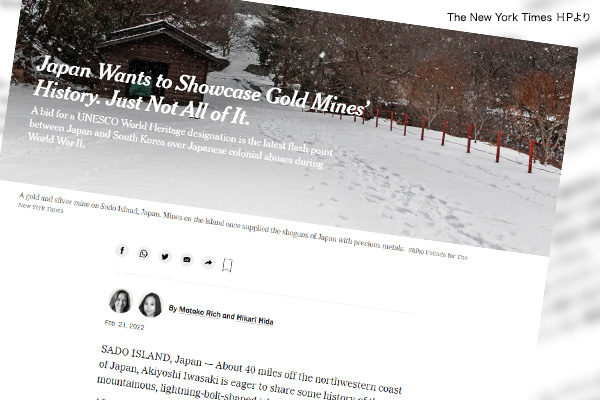The New York Times carried an extremely unbalanced article on February 21 about Sado gold mines that the Japanese government recommended as a candidate for World Cultural Heritage designation by the United Nations Educational, Scientific and Cultural Organization (UNESCO). The online edition of the article is titled “Japan Wants to Showcase Gold Mines’ History. Just Not All of It.”
As indicated by the title, the article writes in line with South Korea’s assertion that Japan is attempting to conceal history concerning Koreans’ wartime labor at the Sado gold mines. This article is biased in two points.
Swallowing forced labor theory
First, the article’s writers, though reporting from Sado Island, Niigata Prefecture, failed to interview anyone who knows why Sado City and Niigata Prefecture have limited the period for World Cultural Heritage designation to the Edo era long before World War II. The article swallows South Korean media reports that Japan limited the period to conceal the history of the gold mines during the war.
However, the limitation only reflected an advice from experts involved in the screening of UNESCO designations, rather than any concern about the wartime history: The Sado gold mines introduced Western technologies after the Edo era, meaning that the remains of Western technologies are seen at various locations in the world and have low value, while Sado’s unique drilling technologies using only basic hand tools during the Edo era for achieving one of the world’s leading production levels have high value. This is the fact that anyone can get by interviewing individuals concerned on the island.
Second, the article says, “Yet there is a darker part of Sado’s history […]: the period during World War II when about 1,500 Koreans were conscripted to work in the mines as subjects of Japan’s colonial rule.” It regards Korean workers as having been engaged in “forced labor” at the mines. The article only cites comments by Japanese historian Yasuto Takeuchi as the evidence of forced labor. “Mr. Takeuchi said he had reviewed records of more than 100 Korean laborers who tried to escape the mines — evidence, he said, that they were forced to be there.”
According to primary historical sources, 1,005 Korean workers went to work at the Sado mines through recruitment by 1943, including 148 who escaped the mines later. The New York Times article says they “tried to escape the mines,” giving impression that they faced stiff police crackdown. Actually, however, they did escape the mines. In fact, the average escape rate for Korean workers mobilized by Japan during the war stood at around 40%, far higher than for Korean workers at the Sado gold mines. The biggest reason for the escape was to get better-paid jobs. As young Japanese men left their workplaces due to military draft, wages rose sharply, prompting brokers to pick out Korean workers.
Ignoring different academic opinions
The article failed to take up opinions of scholars like me who deny Koreans’ wartime forced labor and insist that the presence of escapers could not be adopted as evidence of forced labor. This may be the reason the article got extremely biased. Not only Takeuchi but also American, South Korean and German scholars quoted in the article all take a stance that there was forced labor. Meanwhile, the article quoted Sado residents as asserting that Korean workers were treated in the same way as Japanese workers. This is interpreted as creating an impression that residents are ignorant of history.
Tsutomu Nishioka is a senior fellow and a Planning Committee member at the Japan Institute for National Fundamentals and a visiting professor at Reitaku University. He covers South and North Koreas.


